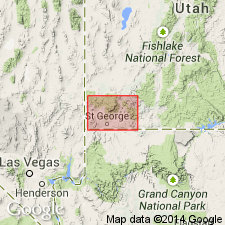
- Usage in publication:
-
- Leach Canyon tuff
- Modifications:
-
- Areal extent
- AAPG geologic province:
-
- Great Basin province
Summary:
Pg. 138 (fig. 3). Leach Canyon tuff member of Quichapa formation. Geographically extended into eastern Nevada. [Age is Oligocene.]
Source: US geologic names lexicon (USGS Bull. 1200, p. 2125).
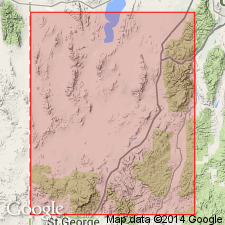
- Usage in publication:
-
- Leach Canyon tuff member
- Modifications:
-
- Original reference
- Dominant lithology:
-
- Tuff
- AAPG geologic province:
-
- Great Basin province
Summary:
Pg. 90-91, 92 (fig. 2), 98. Leach Canyon tuff member of Quichapa formation. Single depositional unit, uniform in lithology through thickness of 450 to 500 feet. Except at base and near top, rock consists of matrix with texture of unglazed porcelain, gray to flesh in color, enclosing fragments of dark-red felsite, light-gray pumice, and other rocks, and crystals of quartz, feldspar, biotite, and other pyrogenic minerals, mostly broken. Basal member of formation; at type locality, underlies Swett tuff member (new); overlies Hole-In-The-Wall member of Isom formation (both new); elsewhere, lava flows or other volcanic rocks, local in origin and extent, present at contacts. Has zircon age of 28 million years; this suggests that Quichapa formation is Oligocene. Discussion of ignimbrites of area.
Type locality: south side of Leach Canyon, Iron Springs district, Desert Mound 7.5-min quadrangle, Iron Co., southwestern UT.
Source: US geologic names lexicon (USGS Bull. 1200, p. 2125).
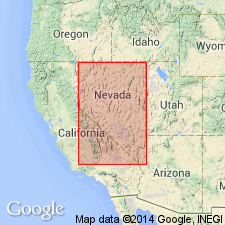
- Usage in publication:
-
- Leach Canyon Tuff
- Modifications:
-
- Revised
- AAPG geologic province:
-
- Great Basin province
Summary:
Leach Canyon Tuff. Raised to formation rank. In the Pahroc and Hiko Ranges consists of at least three ignimbrites. Well exposed in Condor Canyon, near Ursine, in Black Canyon, and in White River Narrows, Nevada. Covers 5,000 to 7,000 sq mi (Nevada and Utah); estimated volume over 500 cu mi.
Source: GNU records (USGS DDS-6; Menlo GNULEX).
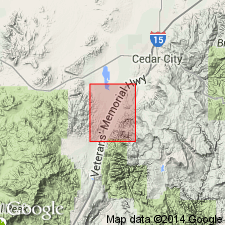
- Usage in publication:
-
- Leach Canyon Tuff Member*
- Modifications:
-
- Adopted
- Age modified
- AAPG geologic province:
-
- Great Basin province
Summary:
Leach Canyon Tuff Member of the Quichapa Formation of Mackin (1960) is adopted by the USGS. Except near base, consists of a matrix with appearance of unglazed gray to flesh-colored porcelain, enclosing fragments of dark-red felsite, light-gray pumice, and other rocks, and crystals of quartz, feldspar, biotite, and other pyrogenic minerals, most of which are broken. At base is a black, gray, or salmon colored vitrophyre ranging from 0 to several 10s of feet thick. Thickness at type 450 to 500 feet. Age is considered Oligocene or Miocene [no basis given for age assignment].
Type locality: south side of Leach Canyon, Iron Springs district, in southern part of T. 36 S., R. 13 W., Desert Mound 7.5-min quadrangle, Iron Co., southwestern UT. Named from Leach Canyon.
Source: Publication; Changes in stratigraphic nomenclature, 1967 (USGS Bull. 1274-A, p. A12); GNU records (USGS DDS-6; Menlo GNULEX).
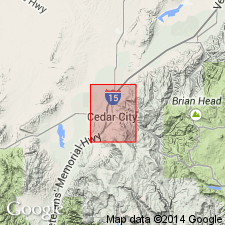
- Usage in publication:
-
- Leach Canyon Tuff Member*
- Modifications:
-
- Age modified
- AAPG geologic province:
-
- Great Basin province
Summary:
Leach Canyon Tuff Member of Quichapa Formation. Age changed from Oligocene or Miocene --to-- early Miocene, based on isotopic (K-Ar) age determinations of 24.0 +/-0.5 Ma to 22.3 +/-0.5 Ma by Armstrong (Geochemica et Cosmochimica Acta, v. 34, p. 203-232, 1970).
Exposed in secs. 24 to 25, T. 35 S., R. 11 W., Cedar City 7.5-min quadrangle, Iron Co., southwestern UT.
Source: Changes in stratigraphic nomenclature, 1974 (USGS Bull. 1405-A, p. A12-A13); GNU records (USGS DDS-6; Menlo GNULEX).
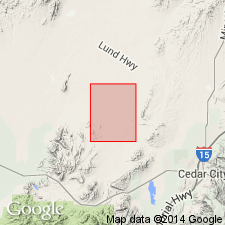
- Usage in publication:
-
- Leach Canyon Formation*
- Modifications:
-
- Areal extent
- AAPG geologic province:
-
- Great Basin province
Summary:
Leach Canyon Formation is geographically extended into northern Antelope Range, Iron County, southwestern Utah. Age is Miocene.
Source: GNU records (USGS DDS-6; Menlo GNULEX).
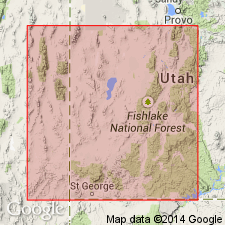
- Usage in publication:
-
- Leach Canyon Formation*
- Modifications:
-
- Adopted
- AAPG geologic province:
-
- Great Basin province
Summary:
Pg. B10-B11 (fig. 2), B12-B13; see also Anderson and Rowley, 1975, GSA Spec. Paper 160, p. 1-51. Leach Canyon Tuff of Quichapa Group is adopted by the USGS. [Following Williams, 1967, Univ. Washington PhD dissert.; Cook, 1965, Nevada Bur. Mines Rpt., no. 11], Leach Canyon Tuff Member raised in rank, assigned to Quichapa Group (now raised in rank), and divided into (ascending) Narrows and Table Butte Tuff Members. Recognized in southwestern Utah and eastern Nevada. Age is Miocene, based on K-Ar age determinations of 22.3 to 24.0 Ma (citing Armstrong, 1970, Geochemica et Cosmochimica Acta, v. 34; Fleck and others, 1975, GSA Spec. Paper 160, p. 53-62).
Source: Publication; Changes in stratigraphic nomenclature, 1976 (USGS Bull. 1435-A, p. A54-A55).
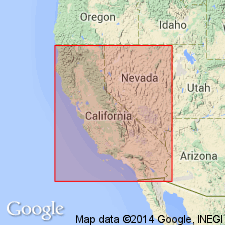
- Usage in publication:
-
- Leach Canyon Formation*
- Modifications:
-
- Areal extent
- AAPG geologic province:
-
- Great Basin province
Summary:
Leach Canyon Formation geographically extended to east side of South Pahroc Range from about a mi south of Mackie perlite mine to near south edge of range. Described as poorly welded, white to light-tan ash-flow tuff approximately 400 ft thick. Age given as Miocene based on isotopic ages of 24 to 22 Ma (Ekren and others, 1977).
Source: GNU records (USGS DDS-6; Menlo GNULEX).
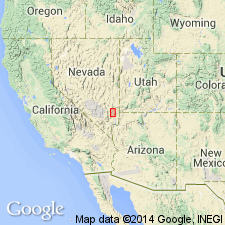
- Usage in publication:
-
- Leach Canyon Formation*
- Modifications:
-
- Areal extent
- AAPG geologic province:
-
- Great Basin province
Summary:
Leach Canyon Formation geographically extended into Meadow Valley Mountains, Lincoln County, Nevada. [Age not stated.]
Source: GNU records (USGS DDS-6; Menlo GNULEX).
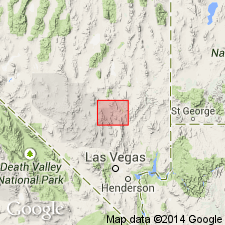
- Usage in publication:
-
- Leach Canyon Formation*
- Modifications:
-
- Mapped
- AAPG geologic province:
-
- Great Basin province
Summary:
(advance copy). Leach Canyon Formation geographically extended into report area [Pahranagat Range]. Age is considered Oligocene and (or) Miocene.
Source: Modified from GNU records (USGS DDS-6; Menlo GNULEX).
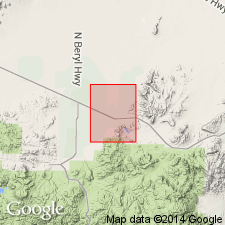
- Usage in publication:
-
- Leach Canyon Formation*
- Modifications:
-
- Age modified
- Mapped 1:24k
- AAPG geologic province:
-
- Great Basin province
Summary:
Leach Canyon Formation of Quichapa Group. Soft to moderately resistant, pink, tan, light-purple, reddish-brown, light-gray, poorly to moderately welded, crystal-poor, rhyolitic ash-flow tuff. Comprises several compound cooling units: the upper, less welded units belong to Table Butte Tuff Member and the lower, more welded units belong to Narrows Tuff Member (Williams, 1967; Anderson and Rowley, 1975). Members not separately mapped. Thickness about 160 m (incomplete). Average isotopic age is 24.7 Ma based on 3 recalculated K-Ar ages on biotite, sanidine, and plagioclase by Armstrong (1970, Geochemica et Cosmochimica Acta, v. 34, p. 203-232), but there is significant variation in these ages (22.9 to 26.7 Ma). Age is changed from Miocene to Oligocene based on recalculation of isotopic ages and using 24 Ma as Oligocene-Miocene boundary.
Source: Publication.
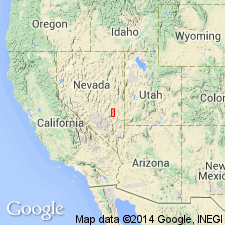
- Usage in publication:
-
- Leach Canyon Formation*
- Modifications:
-
- Areal extent
- AAPG geologic province:
-
- Great Basin province
Summary:
Leach Canyon Formation geographically extended into Seaman Range, Lincoln and Nye Counties, Nevada. Radiometric age of 24.6 Ma (Armstrong, 1970, Geochemica et Cosmochimica Acta, v. 34, p. 203-232, recalculated using decay constants of Steiger and Jager, 1977).
Source: GNU records (USGS DDS-6; Menlo GNULEX).
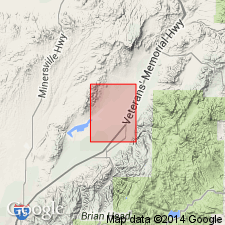
- Usage in publication:
-
- Leach Canyon Formation*
- Modifications:
-
- Mapped 1:24k
- Dominant lithology:
-
- Tuff
- AAPG geologic province:
-
- Great Basin province
Summary:
Leach Canyon Formation of Quichapa Group. Moderately resistant to resistant, white to grayish-orange-pink, rhyolitic, partly to moderately welded ash-flow tuff. Typically erodes to hoodoos. Maximum exposed thickness about 120 m. May include both members, Table Butte Tuff Member and underlying Narrows Tuff Member. Defined by Williams (1967). Age is Oligocene. Average K-Ar age 24.7 Ma (citing Armstrong, 1970, Geochemica et Cosmochimica Acta, v. 34, p. 203-232).
Source: Publication.
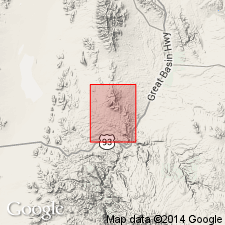
- Usage in publication:
-
- Leach Canyon Formation*
- Modifications:
-
- Age modified
- Areal extent
- AAPG geologic province:
-
- Great Basin province
Summary:
Leach Canyon Formation is extended into the southern Chief Range, Lincoln County, Nevada. Age (local) is Oligocene and Miocene(?).
Source: GNU records (USGS DDS-6; Menlo GNULEX).
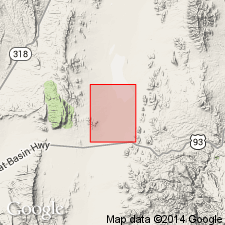
- Usage in publication:
-
- Leach Canyon Formation*
- Modifications:
-
- Mapped 1:24k
- AAPG geologic province:
-
- Great Basin province
Summary:
Leach Canyon Formation of Quichapa Group. Soft, grayish-pink to light-brown, poorly to densely welded, crystal-poor, rhyolitic ash-flow tuff. A simple cooling unit composed of two zones: an upper zone of light-colored, poorly to moderately welded, pumice-rich ash-flow tuff and a lower zone of darker colored, moderately to densely welded and slightly more crystal-rich tuff. Thickness at least 50 m; base not exposed in map area. Age is Oligocene, based on average isotopic (K-Ar) age of 24.7 Ma and using 24 Ma as Oligocene-Miocene boundary. Average isotopic age based on 3 recalculated age determinations (Armstrong, 1970, Geochemica et Cosmochimica Acta, v. 34, p. 203-232): (1) 26.7 Ma (plagioclase) from Nevada; (2) 24.6 Ma (biotite) from Utah; and (3) 22.9 Ma (sanidine) from Utah.
[Leach Canyon now considered late Oligocene; Oligocene-Miocene boundary currently (ca. 2004) placed at 23.03 +/-0.5 Ma.]
Source: Publication; GNU records (USGS DDS-6; Menlo GNULEX).
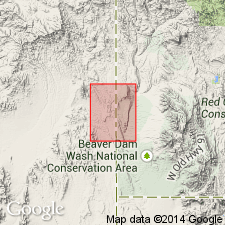
- Usage in publication:
-
- Leach Canyon Formation*
- Modifications:
-
- Mapped 1:24k
- AAPG geologic province:
-
- Great Basin province
Summary:
Leach Canyon Formation of Quichapa Group. Grayish-pink, poorly welded, crystal-poor, rhyolitic ash-flow tuff. Age is Oligocene, based on average K-Ar age of 24.7 Ma (citing Rowley and Shroba, 1991, USGS GQ-1701, Indian Cove quadrangle).
Exposed only in sec. 30, T. 9 S., R. 71 E., Lincoln Co., NV, where it is about 6 m thick.
Source: Publication.
For more information, please contact Nancy Stamm, Geologic Names Committee Secretary.
Asterisk (*) indicates published by U.S. Geological Survey authors.
"No current usage" (†) implies that a name has been abandoned or has fallen into disuse. Former usage and, if known, replacement name given in parentheses ( ).
Slash (/) indicates name conflicts with nomenclatural guidelines (CSN, 1933; ACSN, 1961, 1970; NACSN, 1983, 2005, 2021). May be explained within brackets ([ ]).

